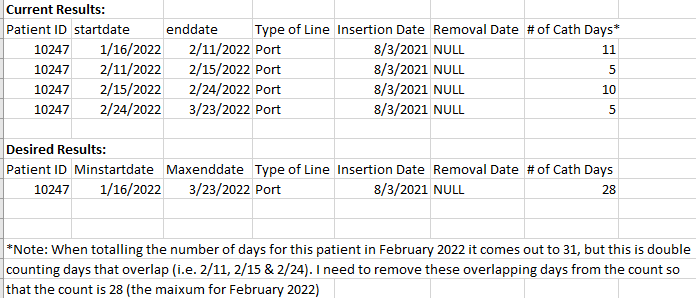I am trying to group a total count of days within a month that a patient had a catheter line inserted. The data is broken down into stints so is not contiguous throughout the month. I also do not to count overlapping days between the stints.
I tried grouping by patient and adding a sum of days at the patient group level in SQL Reporting Services, but could not get around the overlapping days so the counts are all wrong.
See screenshot and query below.
DECLARE @start_date DATETIME
DECLARE @end_date DATETIME
SET @start_date = '2/1/2022'
SET @end_date = '2/28/2022';
CREATE TABLE mytable(
Patient_ID INTEGER NOT NULL PRIMARY KEY
,startdate DATE NOT NULL
,enddate DATE NOT NULL
,Type_of_Line VARCHAR(4) NOT NULL
,Insertion_Date DATE NOT NULL
,Removal_Date DATE
,_of_Cath_Days INTEGER NOT NULL
);
INSERT INTO mytable(Patient_ID,startdate,enddate,Type_of_Line,Insertion_Date,Removal_Date,_of_Cath_Days) VALUES (10247,'2022-01-16','2022-02-11','Port','2021-08-03 00:00:00.000',NULL,11);
INSERT INTO mytable(Patient_ID,startdate,enddate,Type_of_Line,Insertion_Date,Removal_Date,_of_Cath_Days) VALUES (10247,'2022-02-11','2022-02-15','Port','2021-08-03 00:00:00.000',NULL,5);
INSERT INTO mytable(Patient_ID,startdate,enddate,Type_of_Line,Insertion_Date,Removal_Date,_of_Cath_Days) VALUES (10247,'2022-02-15','2022-02-24','Port','2021-08-03 00:00:00.000',NULL,10);
INSERT INTO mytable(Patient_ID,startdate,enddate,Type_of_Line,Insertion_Date,Removal_Date,_of_Cath_Days) VALUES (10247,'2022-02-24','2022-03-23','Port','2021-08-03 00:00:00.000',NULL,5);
WITH stat
AS (SELECT pt.ptkey,
ptid,
ptptinfusionstatus.startdate,
ptptinfusionstatus.enddate
FROM pt
LEFT JOIN ptptinfusionstatus
ON ptptinfusionstatus.ptkey = pt.ptkey
LEFT JOIN ptinfusionstatus
ON ptinfusionstatus.ptinfusionstatuskey =
ptptinfusionstatus.ptinfusionstatuskey
WHERE ptptinfusionstatus.ptinfusionstatuskey IN ( 1, 5 )),
access1
AS (SELECT d.NAME,
d.pharmacyeventandoutcometypedetailkey,
T.pharmacyeventandoutcometypekey
FROM pharmacyeventandoutcometypedetail d WITH (nolock)
LEFT JOIN pharmacyeventandoutcometype t WITH (nolock)
ON t.pharmacyeventandoutcometypekey =
d.pharmacyeventandoutcometypekey
LEFT JOIN pharmacyeventandoutcomelist l WITH (nolock)
ON l.pharmacyeventandoutcomelistkey =
t.pharmacyeventandoutcomelistkey
WHERE l.pharmacyeventandoutcomelistkey = 2),
access2
AS (SELECT stat.ptkey,
stat.ptid,
stat.startdate,
stat.enddate,
Isnull(devicetype.NAME, '') [Access Device_Type],
ppad.insertiondate [Access Device_Insertion Date],
ppad.removaldate [Access Device_Removal Date]
FROM stat WITH (nolock)
JOIN pharmacyptaccessdevice ppad WITH(nolock)
ON ppad.ptkey = stat.ptkey
LEFT JOIN access1 devicetype WITH (nolock)
ON devicetype.pharmacyeventandoutcometypedetailkey =
ppad.accessdevicetypekey
AND devicetype.pharmacyeventandoutcometypekey = 4)
--***MAIN QUERY***
SELECT access2.[ptid] AS 'Patient ID',
access2.startdate,
access2.enddate,
access2.[access device_type] AS 'Type of Line',
access2.[access device_insertion date] AS 'Insertion Date',
access2.[access device_removal date] AS 'Removal Date',
Datediff(d, CASE WHEN [access device_insertion date] >= @start_date AND
[access device_insertion date] >=access2.startdate THEN
access2.[access device_insertion date] WHEN access2.startdate >=
access2.[access device_insertion date] AND
access2.startdate >= @start_date THEN access2.startdate ELSE @start_date
END,
CASE WHEN @end_date <= Isnull(access2.enddate, @end_date) AND @end_date
<= Isnull(access2.[access device_removal date], @end_date) THEN @end_date
WHEN access2.enddate IS NOT NULL AND access2.enddate < @end_date AND
access2.enddate <= Isnull(access2.[access device_removal date],
access2.enddate) THEN access2.enddate ELSE
access2.[access device_removal date] END) + 1 AS '# of Cath Days'
FROM access2
WHERE access2.startdate <= @end_date
AND ( access2.enddate >= @start_date
OR access2.enddate IS NULL )
AND access2.[access device_insertion date] <= @end_date
AND ( access2.[access device_removal date] >= @start_date
OR access2.[access device_removal date] IS NULL )
AND access2.ptid = '10247'
